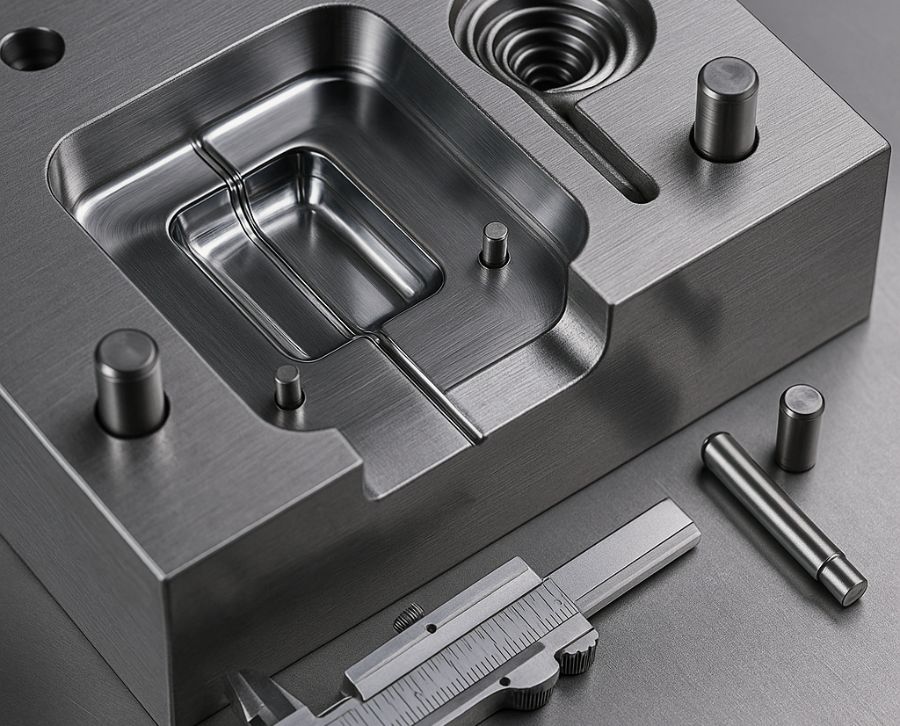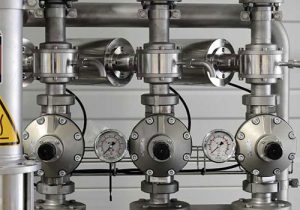When we talk about large-scale industrial production, plastic injection molds often go unnoticed, but they are actually at the heart of it all. They are present in many of the objects we use every day, and their design directly influences the quality, time, and cost of the process.
At Atienza&Climent, as a specialized mold manufacturer, we explain what this process is, how it directly affects your production, and what you need to know to choose the right mold.

The mold: the heart of the plastic injection process
Every product we use every day, from electronic components to household items such as packaging and toys, is created from a mold. And if they’re polymers, they’re part of the plastic injection process, a method for producing parts with guaranteed precision and on a large scale.
Its complexity and design allow a molten liquid to be transformed into a ready-to-use part in a matter of hours. Therefore, the mold’s performance directly affects the cost, production speed, and quality of the final result.
What is an injection mold and why is it a critical investment?
An injection mold is a metal structure designed to contain and shape molten plastic. The precision with which it is manufactured directly affects the efficiency of the production process.
Its design is not simple; a number of aspects must be considered, from the type of material, the shape of the part, the production cycle speed, and the required strength.
Although its development involves high initial costs, it is often used in high-volume production, making it worthwhile in the long run. Furthermore, if well designed, it reduces waste and minimizes waiting times between processes, which contributes to the return on investment.
The key parts of a mold: mold holder, cavities and ejection systems
It is made up of a series of elements that work together to ensure the process runs smoothly:
- Mold holder: supports the entire mold structure.
Cavities: These are the hollows that define the shape of the parts to be manufactured. - Ejecting system: This releases the part once the material has cooled and solidified.
- Injection channels: These channels introduce the molten plastic into the mold at high pressure.
- Cooling system: This allows the material to cool so it takes shape quickly and remains stable.
All of these elements must be perfectly aligned and coordinated for the production process to run as expected.
Alignment errors, inadequate finishes, or failure to make the necessary adjustments can lead to failures in the final part. Therefore, the development of plastic injection molds requires the utmost precision.
The process of making a mold step by step
The process of creating injection molds is neither quick nor easy. It requires experience, machinery, technical tools, and extensive knowledge of the materials to be used.
Design and simulation: The stage where success is defined
The first phase is the design and simulation of the part. A mold is prototyped based on the shape, type of plastic, and the requirements of the process itself. Specialized programs and software are used to model the injection process, allowing potential defects to be anticipated before any material is cut.
During this phase, the number of cavities, cooling channels, and the position of the injection system are also determined. The goal is to achieve a fully optimized design that allows for error-free injection molding of plastic parts.
Steel selection: the decision that determines durability and price
One of the most important choices in manufacturing is the type of steel. Not all molds require the same mechanical properties. For short production runs, pre-hardened steel can be used, while for long runs, high-strength hardenable steels are preferred.
The type chosen will affect both the mold’s performance and its cost. Therefore, a thorough understanding of the final product’s requirements will help you adjust the price of the plastic injection mold without compromising quality.
Precision machining (CNC) Creating the mold cavities
Once the design is approved, the next step is to physically manufacture the cavities where the parts will be formed. This is achieved using high-precision CNC machines capable of reproducing complex shapes. This is where the actual shaping of the injection mold begins.
Heat treatment and fine tuning: ensuring hardness and perfect fit
Machined parts undergo heat treatments that increase their hardness and resistance to wear and tear. Once tempered, final adjustments are made, fitting each component with millimeter precision.
This last adjustment is what allows plastic molds to work for several cycles in a row without losing precision.
Testing and validation (T1) The first plastic injection
Once the mold is assembled, the first functional test, called T1, is performed. Plastic is injected under real-life production conditions to verify that the part’s shape, surface, and mechanical properties meet expectations.
This is the stage where everything planned in the design and simulation is verified to be true. If adjustments need to be made, they are made at this stage, before starting serial production.
What does the price of an injection mold depend on?
There is no universal figure for the price of injection molds; it really depends on several factors involved in the creation process:
Complexity of the part: the more details, the higher the cost
Part design directly influences the mold. Elements such as ribs, clips, thin walls, or shapes with complex finishes require more advanced solutions. Greater complexity means more design work, more machining hours, and, therefore, higher costs for plastic injection molds.
Type of steel and number of cavities
The choice of steel and the number of cavities are two fundamental variables to consider. Manufacturing a single-cavity mold for 10,000 cycles is not the same as manufacturing a multi-cavity mold for several parts. In this sense, plastic injection mold prices vary depending on the production goals.
Surface finishes and required tolerances
The type of finish required for a part also affects the price. A mold designed for complex or textured surfaces requires extra treatment and special care during and after manufacturing. This will inevitably increase the price.
Atienza and Climent: your strategic partner in mold manufacturing
For more than three decades, at Atienza y Climent, we have been supporting industrial companies in the development and manufacturing of injection molds. Our team specializes in projects where precision and durability are essential.
We employ cutting-edge technology, from CAD/CAM design to high-speed CNC machining centers, and we work with certified steels to ensure a reliable and cost-effective result.
Whether you need an aluminum injection mold or are looking to develop a high-volume multi-cavity mold, we offer a solution tailored to your project.
Over 30 years of experience in high-precision molding
We have over 30 years of experience producing competitively priced plastic injection molds, always committed to delivering a mold that performs as intended from the very first piece.
We analyze your project to optimize costs and guarantee quality
Every client, every piece, and every project is unique. That’s why, at Atienza & Climent, our team is dedicated to understanding production needs, expected volume, material type, and usage conditions.
From there, we develop the best possible strategy, which can range from manufacturing an aluminum injection mold to creating thermoplastic tooling. We adapt to you and your project’s needs.
Preguntas frecuentes sobre lCómo se fabrican los moldes para inyección de plástico
Es una herramienta metálica de alta precisión que da forma al polímero fundido; su diseño determina calidad, tiempos de ciclo y coste por pieza.
Aunque el coste inicial es alto, bien diseñado reduce desperdicios, defectos y tiempos de espera, amortizándose en series medias-largas.
Porta-molde, cavidades, sistema de inyección y canales, expulsión y refrigeración; todos deben estar alineados para evitar fallos.
Diseño y simulación → selección de acero → mecanizado CNC de cavidades → tratamiento térmico y ajuste fino → prueba T1 y validación.
Pretemplado para series cortas y templables de alta resistencia para largas; la elección impacta durabilidad y precio.
La primera inyección en condiciones reales para validar forma, superficie y propiedades mecánicas y cerrar ajustes antes de serie.
Complejidad de la pieza, tipo de acero, número de cavidades, tolerancias y acabados superficiales requeridos.



